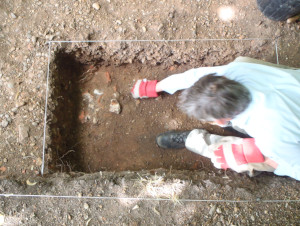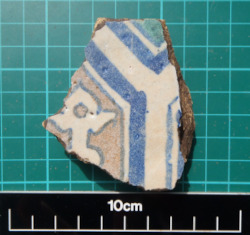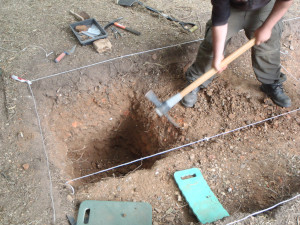13 Jul 2022
Summer Dig - Day 4

We soldiered on today in Forty Hall as the heatwave relented only very slightly, bringing welcome cloud cover at least for the morning, although by lunchtime we were again baking in unforgiving sunshine. It rained overnight, but you wouldn't have known it; the water having evaporated almost before it hit the ground.
This is inevitably baking the exposed brickearth and gravel contexts and making excavation even harder going, but despite this we once again got a decent amount of digging done.
In trench 1, we finished removing the pebble landscaping context to reveal the layer of larger rubble and brickearth which lay beneath, across the entire trench.
This context is not level, and slopes noticeably (as does the ground level), from the lime tree avenue out to the western end of the trench.
In order to get an idea of how thick this deposit is, we opened a small sondage at the west end of the trench, and later enlarged it in the afternoon. We have not yet found the bottom of this context, the sondage having reached a depth so far of almost a metre, and the lower half of it contains fairly sizeable brick fragments and quite a lot of mortar.
The interpretation of this context is uncertain at the moment, but given its sloping surface it may be the fill of a (very large) cut, or possibly another wide area of post-demolition landscaping. The presence of mortar throughout the rubble does suggest it hasn't travelled far, which may be a promising sign for the gatehouse hunt.

It was a similar story in trench 2, where we opened another sondage halfway along the trench, again to preview its stratigraphy.
This sondage was rather more tantalising, however, in that it disclosed a very dense patch of brick rubble and mortar in one corner.
The fact that the rubble is confined to the corner of the sondage suggests that it must either be the fill of a pit, or (hopefully!) the line of a cut, such as an ex-wall line.
Notably, this point of the trench lies in the path of the known portion of the outer courtyard's north range, which must have joined onto the inner gatehouse at some point. It would be great news if we could find evidence for more of the north range, if not the gatehouse itself.
It is also possible that this rubble patch may be overlaying intact wall foundations, but we won't be able to tell any more about this without revealing more of it, which will require more work tomorrow.

Interestingly, small finds were pretty sparse in trench 2 today, especially in comparison to trench 1 which produced a steady stream of pottery, bones and more vessel glass including part of the rim of a delicate glass goblet.
The star find of the day, however, was quite a large fragment of a 'Delft' floor tile, in fact made in London in the early 17th century.
It's of a pattern we've seen before not far away, and together with a much smaller tile fragment found yesterday, is evidence of the decor of the higher status rooms of the palace in the Jacobean period.
